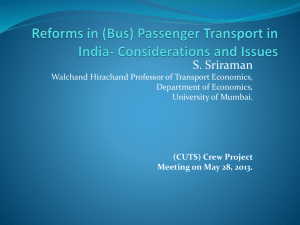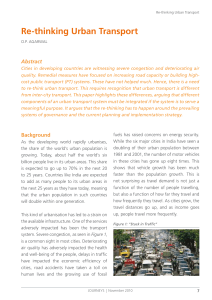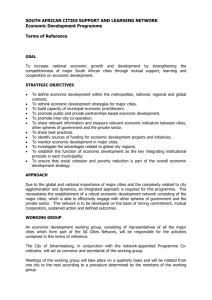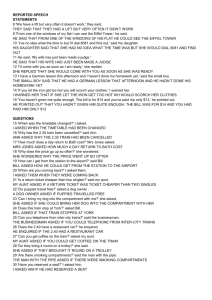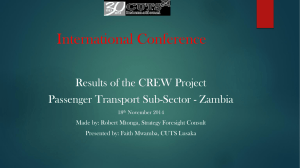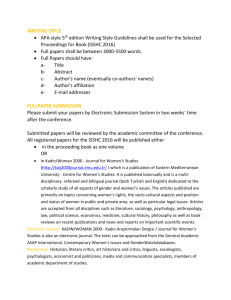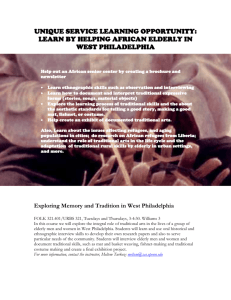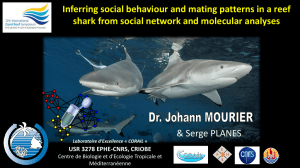Comparing Factors Affecting Intra and Inter
advertisement
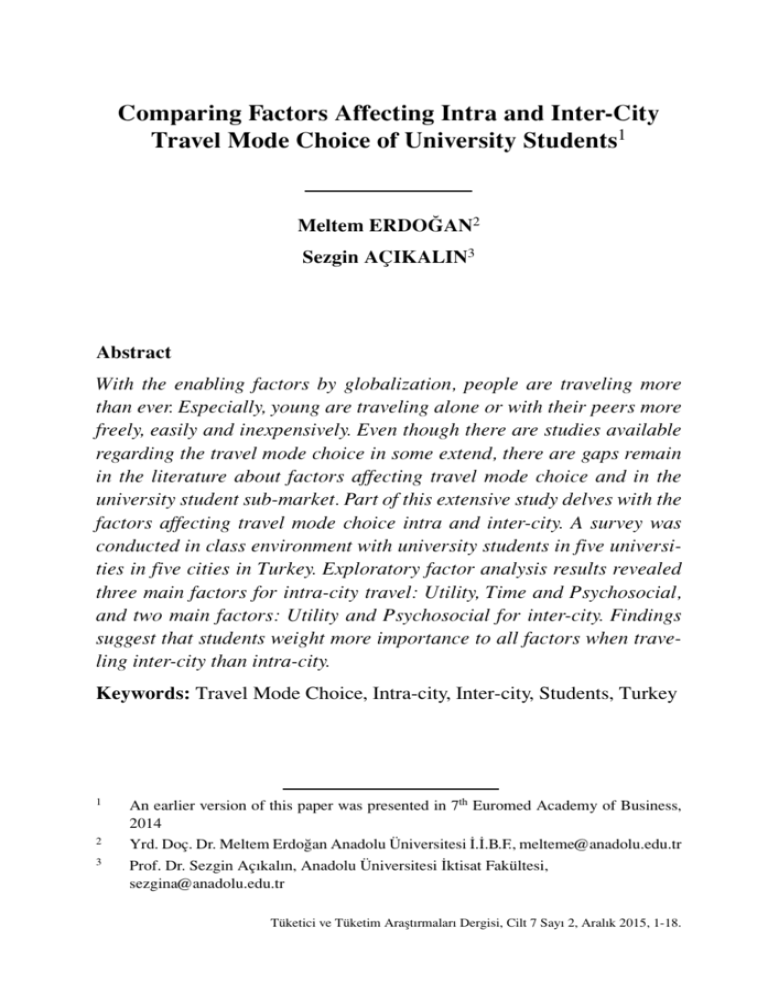
Comparing Factors Affecting Intra and Inter-City Travel Mode Choice of University Students 1 Comparing Factors Affecting Intra and Inter-City Travel Mode Choice of University Students1 Meltem ERDOĞAN2 Sezgin AÇIKALIN3 Abstract With the enabling factors by globalization, people are traveling more than ever. Especially, young are traveling alone or with their peers more freely, easily and inexpensively. Even though there are studies available regarding the travel mode choice in some extend, there are gaps remain in the literature about factors affecting travel mode choice and in the university student sub-market. Part of this extensive study delves with the factors affecting travel mode choice intra and inter-city. A survey was conducted in class environment with university students in five universities in five cities in Turkey. Exploratory factor analysis results revealed three main factors for intra-city travel: Utility, Time and Psychosocial, and two main factors: Utility and Psychosocial for inter-city. Findings suggest that students weight more importance to all factors when traveling inter-city than intra-city. Keywords: Travel Mode Choice, Intra-city, Inter-city, Students, Turkey 1 2 3 An earlier version of this paper was presented in 7th Euromed Academy of Business, 2014 Yrd. Doç. Dr. Meltem Erdoğan Anadolu Üniversitesi İ.İ.B.F., melteme@anadolu.edu.tr Prof. Dr. Sezgin Açıkalın, Anadolu Üniversitesi İktisat Fakültesi, sezgina@anadolu.edu.tr Tüketici ve Tüketim Araştırmaları Dergisi, Cilt 7 Sayı 2, Aralık 2015, 1-18. 2 Meltem ERDOĞAN / Sezgin AÇIKALIN Üniversite Öğrencilerine Ait Şehir İçi ve Şehirlerarası Seyahat Tercihlerini Etkileyen Faktörlerin Karşılaştırılması Öz Küreselleşmenin etkisi ile insanların her zamankinden daha çok seyahat ettikleri gözlenmektedir. Özellikle gençler arkadaşları ile birlikte daha özgür, daha kolay, daha ucuza seyahat etmektedirler. Literatürde seyahat türü seçimine ilişkin çalışmalar olmasına rağmen özellikle üniversite öğrencileri alt piyasasında seyahat türü seçimini etkileyen faktörlere ilişkin yapılan çalışmalar yetersizdir. Alandaki eksikliği kapatmaya çalışan bu çalışmada şehir içi ve şehirlerarası seyahat türünü etkileyen faktörler ortaya konmaya çalışılmıştır. Araştırmanın anket çalışması 5 farklı şehirde yer alan 5 farklı üniversite öğrencilerine sınıf ortamında uygulanmış ve keşifsel faktör analizi sonuçları şehirlerarası seyahat türünü etkileyen fayda, zaman ve psikososyal faktörler ile şehir içi seyahat türünü etkileyen fayda ve psikososyal faktörlere ulaşmıştır. Sonuçlar, öğrencilerin şehir içi seyahat söz konusu olduğunda tüm faktörlere daha fazla önem verdiğini ortaya koymuştur. Anahtar Kelimeler: Seyahat Türü Seçimi, Şehirlerarası, Şehir İçi, Öğrenciler, Türkiye Introduction Economic, psychological and social factors affect customers’ preferences almost every decision about the consumption of goods and services. Travel market is a part of service industry in which decisions are made by customers considering many factors. Indeed, in many travel choice studies undertaken with general public, the unit of analysis is the individual. In the literature, studies treat mode choice as an application of consumer choice theory grounded in the notion that people choose among alternatives to maximize personal utility or net benefit to themselves. Although student travel market worth millions of dollars business, it has not been researched sufficiently (Chadee and Cutler, 1996). In general, little is known about the travel preferences of university students (Shoham, Schrage, and van Eeden, 2004) and factors affecting these preferences. Tüketici ve Tüketim Araştırmaları Dergisi Comparing Factors Affecting Intra and Inter-City Travel Mode Choice of University Students 3 A literature review on university student’s travel mode choice shows that previous studies have focused on four main areas. They can be classified as students’ travel motives and their influence on travel decisions (Kim and Jogaratnam, 2002; Klenosky 2002; Smeaton et al. 1998); associations between motivation and related variables (Josiam et al. 1999); travel patterns and favored activities (Carr 2002, Hsu, and Sung 1997, Field 1999, Kim and Jogaratnam 2003, Michael, Armstrong, and King 2003, Shoham, Schrage, and van Eeden 2004); travel satisfaction (Babin and Kim 2001, Bai et al. 2004). In general, studies conclude that student travelers present a profitable market with different needs and desires. This market also has different patterns of travel and motivation. Therefore, further research in this market should be undertaken with a multi-dimensional perspective (Kim, Oh, Jogaratnam, 2007) including factors affecting travel mode choice. In order to fill above mention gap in the literature, an extensive study exploring university student’s travel mode choice in general and factors affecting intra and inter-city travel mode choices has been undertaken. This paper specifically emphasizes and reports on factors affecting intra and inter-city travel choices. Furthermore, it compares the importance of factors in deciding between two different travel types. Literature Review on Student Travel It has been suggested that people not only use a travel mode because it provides them with the quickest, easiest and cheapest way to get to their destination, they also make a choice of mode based on feelings of excitement and pleasure (Ellaway et al., 2003; Sandqvist, 1997; Steg et al., 2001). University students are a social group that tends to have unique and complex travel behavior. With considerable freedom in the campus environment students are essentially autonomous in their decision making relating to their daily activities with minimal control from the university authorities and their parents. They live, study, socialize with their peers; thus decisions on daily activities of students are regularly affected by their peers. At their age they are open-minded and receptive to new Cilt 7 Sayı 2, Aralık 2015 4 Meltem ERDOĞAN / Sezgin AÇIKALIN ideas from colleagues with various backgrounds and mixed interests. All these factors cause university students to have complicated daily schedules, resulting in complex travel patterns (Limanond, Butsingkorn, Chermkhunthod, 2011). According to Richards and Wilson (2003), around one-fifth of all tourism journeys in the world are made by young people aged 15–25 years, among which students account for a big percentage. The experiences of young travelers today also provide an important basis for their travel decisions later in life. Because of students’ increasing numbers, and their increasing disposable income and mobility nowadays, the student segment is an attractive one to travel and tourism companies, and hence, warrants further research (Hobson and Josiam, 1992; Chadee and Cutler, 1996; Sung and Hsu, 1996; Josiam et al., 1998; Field, 1999; Bai et al., 2004). To understand the university student’s travel behavior, it is necessary to analyze the decision-making process and factors affecting each step of the process. According to widely used models of the consumer decisionmaking process (Engel et al., 1978; Howard and Sheth, 1969; Moutinho, 1987), customers are motivated by particular needs and desires leading to search for information, the evaluation of alternative and the choice of product. Moreover, the individual decision will be influenced by a range of personal, social, market, economic and cultural factors (Xu, Morgan and Song, 2009). Selecting the travel mode choice from which customers derive the greatest utility (or satisfaction) is subject to time and budget constraints. Also decisions about travel modes are affected by the levelof-service that is a function of the time, cost, comfort, and other attributes of the mode used and of the route traveled (Adler and Ben-Akiva 1979). Johansson, Heldt, and Johansson (2006) tested the significance of five individual specific variables’ importance for travel mode choice: environmental preferences, safety, comfort, convenience, and flexibility. Results confirmed that modal time and cost are significant for travel mode choice but respondents indicated that preferences for flexibility and comfort are also very important. Tüketici ve Tüketim Araştırmaları Dergisi Comparing Factors Affecting Intra and Inter-City Travel Mode Choice of University Students 5 Grand (2008) explored the transportation habits of university students in the USA to develop a model of transportation mode choice for trips of 100 miles and more by investigating that whether or not there is a correlation between the urban form in which a student resides and previous use of transit, opinions of transit and willingness to use transit were it free. More specifically, the author sought to identify variables that determine the choice, measure them and quantify their effects. Three main sets of considerations were reasoned to affect the travel mode choice: 1) financial considerations, 2) availability and accessibility of service by different modes and 3) preferences for different types of transportation service, i.e., supply and demand. The author segmented market demands into business and non-business. Auto, air, bus, common carrier and rail were subjected to paired comparisons for non-business and business trips. The percentage favoring auto over common carrier was 77 per cent for nonbusiness trips and 47 per cent for business trips. In contrast, the proportion favoring air over auto rises was 10 per cent for non-business trips and 53 per cent for business trips. The author concluded that preferences of the travel mode choice changed as distance to be traveled is increased. Aarts, Verplanken, and Knippenberg (1997) studied the role of habit in the process of information use underlying daily travel mode choices. Based on the ‘policy capturing’ paradigm, 82 university students performed a multi attribute travel mode judgment task, in which they could use information about travel circumstances to make a number of judgments. Results showed that habit reduced the elaborateness of information use in judgments of travel mode usage. In their study of Hunecke et al. (2001) applied the Schwartz Norm Activation Model (Schwartz, 1977) to a special kind of environmental behavior, namely travel mode behavior. Travel mode choice has become an important topic within the research of environmentally relevant behavior. The objective of Limanond, Butsingkorn, Chermkhunthod (2011) is to investigate the travel patterns of university students with a case study of a rural university in Thailand. Their study aimed to examine various aspects of travel behavior including trip generation, mode split, Cilt 7 Sayı 2, Aralık 2015 6 Meltem ERDOĞAN / Sezgin AÇIKALIN travel distance, and travel time. Lastly, Ewing, Schroeer, and Greene’s (2004) study is the first to examine the relationship between mode of travel to school and the full range of factors that might affect mode choice. Klöckner and Friedrichsmeier (2011) explored travel mode choice in a student sample on four frequent trips: To the university, to work, to the favorite leisure activity, and to the favorite shop. The decision to use the car in a contrast to alternative travel modes is modelled for each individual trip using a two-level structural equation model with trip specific attributes on Level 1 and person specific attributes on Level 2. The study aimed to not only combine the two perspectives on travel mode choice but also the two levels of analysis by modeling travel mode choice both on the disaggregated trip level and the aggregated person level at the same time. According to the authors car availability was an important predictor of travel mode choice that is neither new nor surprising. The easier a car can be accessed at the point in time when the decision is made, the higher, in general, the likelihood that a car is used. Similarly, Simma and Axhausen (2001) were able to show that a car availability is a powerful predictor of both the percentage of car use and the distance travelled. Furthermore, Ben-Akiva and Boccara (1995) showed that car ownership is a more binding constraint of travel mode choice than accessibility of public transportation systems. Van Acker and Witlox (2010) showed that car ownership serves as a mediator between socio-economic/demographic variables built environment characteristics and car use. Green, Morris and Wade (2012) studied the impact of course related travel among nursing students across the UK and overseas. Findings indicated that cost, convenience and reliability found to be key factors in choice of transport for traveling to both university and practice placements necessitating the use of a car because of the fact that paucity of public transport and unreliability. Chen (2012) conducted a statistical analysis of the weekday travel behavior and associated activities specifically for university students. Through this empirical study, the author made recommendations on how to improve the existing travel demand models. Chen argued that findings Tüketici ve Tüketim Araştırmaları Dergisi Comparing Factors Affecting Intra and Inter-City Travel Mode Choice of University Students 7 set the initial stage for ultimately developing comprehensive activitybased travel demand models in the university students travel market. Nkegbe’s et al. (2012) work utilized the multinomial logit-regression to study travel mode choice of 384 non-residential university students in Africa, specifically in Ghana. Findings showed that distance of stay, travel time to campus, mother’s level of education, amount earned by mother, and amount charged to students statistically affect the possibility of walking, riding a motorbike or taking a bus to campus. Bamberg, Ajzen and Schmidht (2003) explored travel mode choice behaviour of university students in Germany with a longitudinal study. The study focused on a high-opportunity behavior such as taking the car or bus to go to campus. It also examined the effects of an intervention designed to increase the number of students riding the bus rather than driving their cars. Results demonstrated the utility of the theory of planned behavior as a conceptual framework for predicting of travel mode choice and for understanding the effects of an intervention on this behavior. Furthermore, attitudes, subjective norms, and perceived behavioral control were found to affect the student’s intentions to take the bus to the campus. Introduction of a prepaid semester bus ticket proved to be an effective intervention, more than doubling the proportion of students riding the bus to the campus, rather than driving their cars. As can be seen from this literature review, there is no study that has investigated factors affecting inter and intra-city travel mode choice in a single study. Also, there is no study that compares the importance of factors that play role in deciding travel mode choice in two different travel types namely intra and inter-city travel. Therefore, this study aims to explore these two understudied areas together. Methodology and Findings In order to achieve aforementioned goals, a survey developed from the literature and findings of ten exploratory interviews was conducted in five universities in five cities in Turkey namely Istanbul, Ankara, Konya, Cilt 7 Sayı 2, Aralık 2015 8 Meltem ERDOĞAN / Sezgin AÇIKALIN Kutahya and Eskisehir. Total 400 questionnaires were distributed and applied in a classroom environment, but 377 usable returns were received. Data was subjected to statistical analysis namely, paired sample t-tests, exploratory (EFA) and confirmatory (CFA) factor analysis, ANOVA, and independent samples t-tests. An earlier version of the paper was presented at a conference during which it was suggested that the missing values should be replaced with mean values before further analysis, which was done. As can be seen in Table-1, respondents are almost evenly distributed in gender and family car ownership. Table 1. Sample Characteristics N % Female Male 192 185 50.9 49.1 Yes No 168 209 44.6 55.4 Yes No 194 183 51.5 48.5 Public Private 234 143 62.1 37.9 Personal Income and/or Allowances Below 200 Euros 200 – 400 Euros Above 400 Euros 160 175 42 42.4 46.4 11.2 41 104 90 39 103 10.9 27.6 23.9 10.3 27.3 Gender Having driver license Family car ownership University type Family Income Below 400 Euros 400 – 800 Euros 801 – 1200 Euros 1201 – 1600 Euros Above 1600 Euros Tüketici ve Tüketim Araştırmaları Dergisi Comparing Factors Affecting Intra and Inter-City Travel Mode Choice of University Students 9 Around 45 percent has a driver license and two-thirds are studying in public universities. Almost 90 percent of the respondents have an income or allowances below 400 Euros per month. Lastly, family income figures indicate that only ten percent of the students come from the poorest families in Turkey. On the other hand, 27 percent of university students are coming from higher income families. Eight factors were identified from the literature and exploratory interviews. Mean scores and paired sample t-test results are shown in Table-2. As can be seen in the table, means scores are higher in all eight factors in intercity travels. In other words, students consider these eight factors more seriously when they decide their travel modes on inter-city than intra-city travels. In order to see whether there are statistically meaningful mean differences, paired-sample t-tests were utilized. Results indicate that there are significant differences in five factors, but environmental concerns, feeling free and reducing stress factors are not statistically significant. Table 2. Comparing Factors Affecting Intra and Inter-city Travels Factors Travel Type Mean t scores Sig. (2-tailed) Price Intra-city Inter-city 3.94 4.10 -3.886 0.001 Safety Intra-city Inter-city 4.07 4.34 -5.908 0.001 Comfort Intra-city Inter-city 3.80 4.22 -9.243 0.001 Speed Intra-city Inter-city 4.04 4.14 -2.373 0.018 Prestige and Status Intra-city Inter-city 2.90 3.19 -6.146 0.001 Environmental concerns Intra-city Inter-city 3.29 3.30 -0.14 0.889 Feeling free Intra-city Inter-city 3.29 3.35 -1.146 0.252 Reducing stress Intra-city Inter-city 2.99 3.04 -0.89 0.374 Cilt 7 Sayı 2, Aralık 2015 10 Meltem ERDOĞAN / Sezgin AÇIKALIN In order to reduce the list of factors to the basic dimensions, the data was subjected to two exploratory factor analysis by using Principal Component Analysis Extraction Method with Varimax Rotation. The first one presented in Table-3 shows the results of the intra-city travel factors and the second one is the results of the inter-city travel factors in Table-4. As tables indicate, all statistics are supporting the use of factor analysis that reduced the number of reasons from eight to three and two, respectively. KMO test scores are also at the high end of the scale indicating that sampling is adequate. The Chi-square score of Bartlett’s test of sphericity are quite high with very high level of significance. Also, Cronbach’s Alpha scores indicating reliability of the measurement scales are above the acceptable percentage. Even though the total variances explained by three and two components (66% and 59%, respectively) seem relatively low, Hair et al. (1995) argue that it is common for social scientists to consider a solution which accounts for 60% or even in some cases even less of the total variance a satisfactory solution. Table 3. Exploratory Factor Analysis for Intra-City Travel Components Psychosocial a= 0.79 Utility a= 0.58 Time a= NA Individual items Feeling free Reducing stress Environmental concerns Prestige and status Loadings 0.899 0.865 0.655 0.560 Safety Price Comfort 0.780 0.733 0.575 Speed 0,933 Eigenvalues 3,08 1,23 1,03 Variance explained (%) 37,9 15,5 12,9 KMO= 0.750; Chi-Square = 667; sig. = 0,0001 Tüketici ve Tüketim Araştırmaları Dergisi Comparing Factors Affecting Intra and Inter-City Travel Mode Choice of University Students 11 First exploratory factor analysis results grouped eight items under three components for intra-city travel (Tables 3). Hair et al. (1995) argue that naming of the components is not scientific and it is usually left to the researcher’s subjectivity. However, the factor loadings indicating the correlation of each variable and component can provide some bases since the higher the factor loading, the more representative of the component is the variable. Utility components represent economic factors and comfort issues. Psychosocial components are related with travelers’ psychological well-being in, and interaction with, their social environment. Time stands out as a single component. The reason for this can be that cities that researched was done are known with a heavy traffic problem such as Istanbul and Ankara. After conducting first exploratory factor analysis and refining the factor structure, the data was subjected to further analysis on AMOS to test factor structure. As can be seen in Table 4, having a χ2/df ratio just above acceptable limits of 2 and 5 (Marsh and Hocevar 1985) and IFI and CFI values near 0,90 (Hu and Bentler, 1999) factor structure indicate an acceptable fit. However, RMSEA value is over 0,06 that is the recently accepted cut-off criteria, but some has found an RMSEA of between 0,08 and 0,10 is acceptable fit (MacCallum et al., 1996). From these results, the intra-city travel factor structure is not robust enough indicating that there are more factors affecting intra-city travel modes which need further inquiry. Table 4. Confirmatory Factor Analysis for Intra-City Travel Chi-square/df CFI NFI IFI RMSEA 5,293 0,89 0,87 0,89 0,101 Table 5 presents second exploratory factor analysis results. As can be seen eight items were loaded under two components for inter-city travel: Utility and Psychosocial. Cilt 7 Sayı 2, Aralık 2015 12 Meltem ERDOĞAN / Sezgin AÇIKALIN Table 5. Exploratory Factor Analysis for Inter-City Travel Components Psychosocial a= 0.82 Utility a= 0.67 Individual items Feeling free Reducing stress Environmental concerns Prestige and status Loadings 0.870 0.843 0.758 0.646 Safety Price Speed Comfort 0.762 0.554 0.720 0.736 Eigenvalues 3.39 1.32 Variance explained (%) 42.3 16.5 KMO= 0.795; Chi-Square = 808; sig. = 0,0001 Again after conducting second exploratory factor analysis and refining the factor structure, the data was subjected to further analysis on AMOS to test factor structure. As can be seen in Table 6, the inter-city travel factor structure is robust. In other words, findings of confirmatory factor analysis confirm factor structure assessed by the second exploratory factor analysis. Table 6. Confirmatory Factor Analysis for Inter-City Travel Chi-square/df CFI NFI IFI RMSEA 4,153 0,93 0,91 0,93 0,092 Several more analysis were run to see whether variables presented in Table-1 make a difference in the importance of components affecting travel mode choice. Results of independent samples t-tests (having a driver license, car ownership, and university type) and ANOVA tests Tüketici ve Tüketim Araştırmaları Dergisi Comparing Factors Affecting Intra and Inter-City Travel Mode Choice of University Students 13 (personal income and family income), reveal no statistically significant differences, except gender. Table-7 shows results of t-tests about gender. As can be seen in the table, females statistically give more weight to components in deciding which travel mode to choose than males in all factors, except psychosocial and time components in intra-city travel. Table 7. Independent Sample Statistics and T-tests Factors Mean Std.Dev. t scores Sig. Female Male 4,27 4,12 0.44 0.67 2,54 0.012 Female Male 4.02 3.82 0.61 0.72 2,85 0.005 Inter-City Travel – Psychosocial Female Male 4.03 3.84 0.54 0.60 3.07 0.002 Intra-City Travel – Psychosocial Female Male 3.18 3.06 0.88 0.92 1.26 0.21 4.10 3.98 0.83 0.98 1.24 0.21 Inter-City Travel – Utility Intra-City Travel – Utility Intra-City Travel – Time Female Male Conclusion and Discussion There are millions of university students in the world. Even though the number is vast, there are neither enough studies related to the student’s travel preferences nor factors that affect travel mode choice in different travel types. After literature review, it was clear that there need to be more studies undertaken in this important market. After identifying these gaps, an extensive research project was undertaken in which these findings are a part. Integrating exploratory interview findings with the existing Cilt 7 Sayı 2, Aralık 2015 14 Meltem ERDOĞAN / Sezgin AÇIKALIN literature resulted eight factors along with traveler characteristics that play role in the choice of travel mode. Eight factors were subjected to exploratory and confirmatory factor analysis which reduced these factors to three main components for the intra-city travel and two main components for the inter-city travel. Analyses show that when university students make a choice on travel modes, they take this issue seriously regardless of travel type. Both factor analyses show that university students take two main components, namely utility and psycho-social, into consideration when they take their travelling decisions. This result supports the previous literature in the area. On the other hand, speed accepted here as time component stood separate in the intra city travelling. This may be a result of heavy traffic problems in the cities that the study was conducted. One of the important findings comes to surface when the gender difference is explored. Female students consider both utility and psycho-social components statistically more seriously than male students. Furthermore, utility components are weighted more important than psycho-social components regardless of gender and travel type by students. More specific results show that five (price, safety, comfort, speed, and prestige and status) out of eight explored factors indicated statistically meaningful mean differences of the factors between intra and inter-city travelling. However, safety and speed are the most important factors affecting both intra-city and intercity travelling modes. The findings have important implications for theory and practice. For theory, there is a need for further studies which will take multidisciplinary approach to the area. Also, there is a need for cross-cultural studies as each society has its own values affecting the decision making process. This research has taken the consumer’s perspective, but also it may be studied from suppliers and policymakers perspectives. Since travelling will be more and more with increasing globalization and new technologies, suppliers and policymakers will need more information about the customers of this industry. These types of studies may provide much needed information to all parties that have a stake in this field Tüketici ve Tüketim Araştırmaları Dergisi Comparing Factors Affecting Intra and Inter-City Travel Mode Choice of University Students 15 to make effective and optimal decisions. Similar studies on sub-market (e.g. elderly or handicapped) could supply very important and valuable information to policy makers which in turn they could use to organize government future policies in the travel sector to have the best outcome for whole society. References Aarts, H. Verplanken, B. and Knippenberg A. (1997), “Habit and Information Use in Travel Mode Choices”, Acta Psychologica, 96, 1-14. Adler, T. and Ben-Akiva, M. (1979), “A Theoretical and Empirical Model of Trip Chaining Behavior”, Transportation Research, 13B, 243257. Babin, B. J. and Kim, K. (2001), “International Students’ Travel Behavior: A Model of the Travel-related Consumer/Dissatisfaction Process”, Journal of Travel and Tourism Marketing, 10, 93–106. Bai, B. Hu, C. Elsworth, J. and Countryman, C. (2004), “Online Travel Planning and College Students: The Spring Break Experience”, Journal of Travel and Tourism Marketing, 17, 79–91. Bamberg, S. Ajzen, I. and Schmidt, P. (2003) ‘Choice of Travel Mode in the Theory of Planned Behavior: The Roles of Past Behavior, Habit, and Reasoned Action’ Basic and Applied Social Psychology, 25, 175–187. Ben-Akiva, M. and Boccara, B. (1995) ‘Discrete Choice Models with Latent Choice Sets’ International Journal of Research in Marketing, 12, 9-24. Carr, N. (2002), “A Comparative Analysis of the Behavior of Domestic and International Young Tourists”, Tourism Management, 23, 321–325. Chadee, DD. and Cutler, J. (1996), “Insights into International Travel by Students”, Journal of Travel Research, 35, 75–80. Cilt 7 Sayı 2, Aralık 2015 16 Meltem ERDOĞAN / Sezgin AÇIKALIN Chen, X. (July 2012) ‘Statistical and Activity-based Modeling of University Student Travel Behavior’ Transportation Planning and Technology, 35, 591–610 Engel, JF. Blackwell, RD. and Kollat, DT. (1978), Consumer Behavior, Dryden Press: Hinsdale, IL, USA. Ewing, R. Schroeer, W. & Greene, W. (2004), “School Location and Student Travel Analysis of Factors Affecting Mode Choice” Journal of the Transportation Research Board, 1895, 55–63. Field, AM. (1999), “The College Student Market Segment: A Comparative Study of Travel Behaviors of International and Domestic Students at a Southeastern University”, Journal of Travel Research, 37, 375–381. Grand, F.L. (2008) ‘The Journey to Campus: Commute Mode Choice for University of Nebraska at Omaha Students’ For the Degree of Masters of Arts in Geography Omaha, Nebraska, The Graduate College at the University of Nebraska, p. 3. Green, G. Morris, J. & Wade, M. (2012) “Health, Sustainability, and Student Travel”, Nurse Education in Practice, 12, 41-45. Hair, Joseph F., Rolph E Anderson, Ronald L Tatham, and William C. Black, (1995), Multivariate Data Analysis with Readings, 4 ed. Prentice-Hall International: London, UK. Hobson, JSP. & Josiam, B. (1992), “Spring Break Student Travel-An Exploratory Study”, Journal of Travel and Tourism Marketing, 1, 87–97. Howard, DJL. & Sheth, JN. (1969), The Theory of Buyer Behavior, John Wiley: New York, USA. Hsu, CH. and Sung, S. (1997), “Travel Behaviors of International Students at a Midwestern University”, Journal of Travel Research, 36, 59–65. Hunecke, M. Blöbaum, A. Matthies, E. and Höger, R. (2001), “Responsibility and Environment Ecological Norm Orientation and ExterTüketici ve Tüketim Araştırmaları Dergisi Comparing Factors Affecting Intra and Inter-City Travel Mode Choice of University Students 17 nal Factors in the Domain of Travel Mode Choice Behavior”, Environment and Behavior, 33, 830-852. Johansson, M.V. Heldt, T. Johansson, P. (2006) ‘The Effects of attitudes and personality Traits on Mode Choice’ Transportation Research Part A, 40, 507-525. Kim, K. Y. and Jogaratnam, G. (2002) “Travel Motivations: A Comparative Study of Asian International and Domestic American College Students”, Journal of Travel and Tourism Marketing, 13, 61–82. Kim, KY. & Jogaratnam, G. (2003), “Activity Preferences of Asian International and Domestic American University Students: An Alternate Basis for Segmentation”, Journal of Vacation Marketing, 9, 260–70. Kim, KY. Oh, Ick-Keun. & Jogaratnam, G. (2007), “College Student Travel: A Revised Model of Push Motives”, Journal of Vacation Marketing, 13, 73–85. Klenosky, DB. (2002), “The Pull of Tourism Destinations: A Means-end Investigation”, Journal of Travel Research, 40, 385–95. Klöckner, C.A. & Friedrichsmeier, T. (2011) ‘A Muti-level Approach to Travel Mode Choice-How Person Characteristics and Situation Specific Aspects Determine Car Use in a Student Sample’ Transportation Research Part F, 14, 261-277. Limanond, T. Butsingkorn, T. & Chermkhunthod, C. (2011) “Travel Behavior of University Students Who Live on Campus: A case Study of a Rural University in Asia”, Transport Policy, 18, 163-171. Michael, I. Armstrong, A. and King, B. (2003), “The Travel Behavior of International Students: The Relationship between Studying Abroad and their Choice of Tourists Destinations”, Journal of Vacation Marketing, 10, 57–66. Moutinho, L. (1987), “Consumer Behavior in Tourism”, European Journal of Marketing, 21, 5-7. Cilt 7 Sayı 2, Aralık 2015 18 Meltem ERDOĞAN / Sezgin AÇIKALIN Nkegbe, P. K. Kuunibe, N. & Abdul-Mumin, Y. (Oct. 2012) Choice of Transport Mode by Non-Resident University Students in Ghana, International Journal of Business and Social Science, 3, 136-142. Richards, G. and Wilson J, (2003), “New Horizons in Independent Youth and Student Travel, A report for the International Student Travel Confederation (ISTC) and the Association of Tourism and Leisure Education (ATLAS)”, International Student Travel Confederation, Amsterdam, NL. Shoham, A. Schrage, C. & Van Eeden, S. (2004), “Student Travel Behavior: A Cross-national Study”, Journal of Travel and Tourism Marketing, 17, 1–10. Simma, A. and Axhausen, K.W. (2001) ‘Structures in Commitment in Mode Use: A Comparison of Switzerland, Germany, and Great Britain’ Transport Policy, 8, 279-288. Smeaton, G. and Clements, CJ. (1999) “Involvement: Travel Motivation and Destination Selection”, Journal of Vacation Marketing, 5, 67– 175. Sung, S. and Hsu, CHC (1996), “International Students’ Travel Characteristics: An Exploratory Study”, Journal of Travel and Tourism Marketing, 5, 277–283. Xu, F. Morgan, M. Song, P. (2009), “Students’ Travel Behavior: A Crosscultural Comparison of UK and China”, International Journal of Tourism Research, 11, 255–268. Van Acker, V. and Witlox, F. (2010) ‘Car Ownership as a Mediating Variable in Car Travel Behavior Research Using a Structural Equation Modelling Approach to Identify its Dual Relationships’ Journal of Transport Geography, 18, 65-74. Tüketici ve Tüketim Araştırmaları Dergisi
